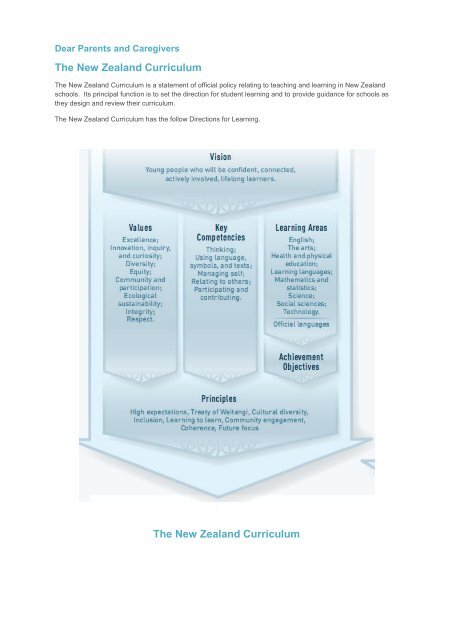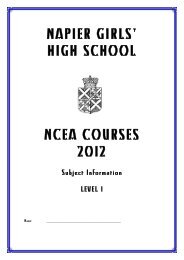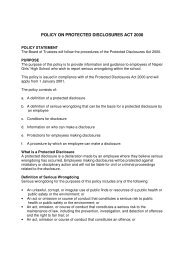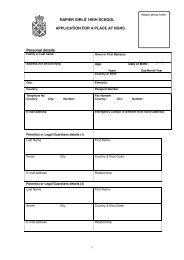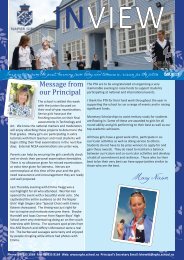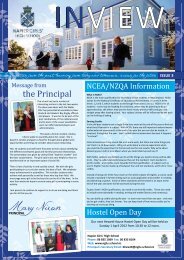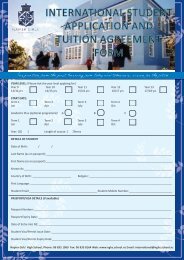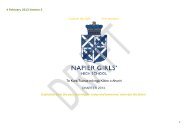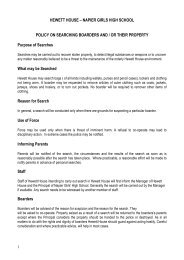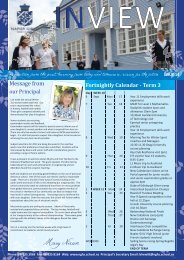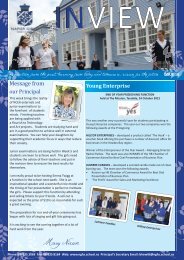The New Zealand Curriculum The New Zealand Curriculum
The New Zealand Curriculum The New Zealand Curriculum
The New Zealand Curriculum The New Zealand Curriculum
Create successful ePaper yourself
Turn your PDF publications into a flip-book with our unique Google optimized e-Paper software.
Dear Parents and Caregivers<strong>The</strong> <strong>New</strong> <strong>Zealand</strong> <strong>Curriculum</strong><strong>The</strong> <strong>New</strong> <strong>Zealand</strong> <strong>Curriculum</strong> is a statement of official policy relating to teaching and learning in <strong>New</strong> <strong>Zealand</strong>schools. Its principal function is to set the direction for student learning and to provide guidance for schools asthey design and review their curriculum.<strong>The</strong> <strong>New</strong> <strong>Zealand</strong> <strong>Curriculum</strong> has the follow Directions for Learning.<strong>The</strong> <strong>New</strong> <strong>Zealand</strong> <strong>Curriculum</strong>
ValuesTo be encouraged, modeled, and exploredValues are deeply held beliefs about what is important or desirable. <strong>The</strong>y are expressed through the ways inwhich people think and act.Every decision relating to curriculum and every interaction that takes place in a school reflects the values of theindividuals involved and the collective values of the institution.<strong>The</strong> values on the list below enjoy widespread support because it is by holding these values and acting on themthat we are able to live together and thrive. <strong>The</strong> list is neither exhaustive nor exclusive.Students will be encouraged to value:excellence, by aiming high and by persevering in the face of difficultiesinnovation, inquiry, and curiosity, by thinking critically, creatively, and reflectivelydiversity, as found in our different cultures, languages, and heritagesequity, through fairness and social justicecommunity and participation for the common goodecological sustainability, which includes care for the environmentintegrity, which involves being honest, responsible, and accountable and acting ethicallyand to respect themselves, others, and human rights.<strong>The</strong> specific ways in which these values find expression in an individual school will be guided by dialoguebetween the school and its community. <strong>The</strong>y should be evident in the school’s philosophy, structures, curriculum,classrooms, and relationships. When the school community has developed strongly held and clearly articulatedvalues, those values are likely to be expressed in everyday actions and interactions within the school.Through their learning experiences, students will learn about:their own values and those of othersdifferent kinds of values, such as moral, social, cultural, aesthetic, and economic valuesthe values on which <strong>New</strong> <strong>Zealand</strong>’s cultural and institutional traditions are basedthe values of other groups and cultures.Through their learning experiences, students will develop their ability to:express their own valuesexplore, with empathy, the values of otherscritically analyse values and actions based on themdiscuss disagreements that arise from differences in values and negotiate solutionsmake ethical decisions and act on them.All the values listed above can be expanded into clusters of related values that collectively suggest their fullermeanings. For example, 'community and participation for the common good' is associated with values andnotions such as peace, citizenship, and manaakitanga.
Key CompetenciesCapabilities for living and lifelong learning<strong>The</strong> <strong>New</strong> <strong>Zealand</strong> <strong>Curriculum</strong> identifies five key competencies:thinkingusing language, symbols, and textsmanaging selfrelating to othersparticipating and contributingPeople use these competencies to live, learn, work, and contribute as active members of their communities. Morecomplex than skills, the competencies draw also on knowledge, attitudes, and values in ways that lead to action.<strong>The</strong>y are not separate or stand-alone. <strong>The</strong>y are the key to learning in every learning area.<strong>The</strong> development of the competencies is both an end in itself (a goal) and the means by which other ends areachieved. Successful learners make use of the competencies in combination with all the other resourcesavailable to them. <strong>The</strong>se include personal goals, other people, community knowledge and values, cultural tools(language, symbols, and texts), and the knowledge and skills found in different learning areas. As they developthe competencies, successful learners are also motivated to use them, recognising when and how to do so andwhy.Opportunities to develop the competencies occur in social contexts. People adopt and adapt practices that theysee used and valued by those closest to them, and they make these practices part of their own identity andexpertise.<strong>The</strong> competencies continue to develop over time, shaped by interactions with people, places, ideas, and things.Students need to be challenged and supported to develop them in contexts that are increasingly wide-rangingand complex.ThinkingThinking is about using creative, critical, and metacognitive processes to make sense of information,experiences, and ideas. <strong>The</strong>se processes can be applied to purposes such as developing understanding, makingdecisions, shaping actions, or constructing knowledge. Intellectual curiosity is at the heart of this competency.Students who are competent thinkers and problem-solvers actively seek, use, and create knowledge. <strong>The</strong>y reflecton their own learning, draw on personal knowledge and intuitions, ask questions, and challenge the basis ofassumptions and perceptions.Using language, symbols, and textsUsing language, symbols, and texts is about working with and making meaning of the codes in which knowledgeis expressed. Languages and symbols are systems for representing and communicating information,experiences, and ideas. People use languages and symbols to produce texts of all kinds: written, oral/aural, andvisual; informative and imaginative; informal and formal; mathematical, scientific, and technological.Students who are competent users of language, symbols, and texts can interpret and use words, number,images, movement, metaphor, and technologies in a range of contexts. <strong>The</strong>y recognise how choices of language,symbol, or text affect people’s understanding and the ways in which they respond to communications. <strong>The</strong>yconfidently use ICT (including, where appropriate, assistive technologies) to access and provide information andto communicate with others.Managing selfThis competency is associated with self-motivation, a “can-do” attitude, and with students seeing themselves ascapable learners. It is integral to self-assessment.
Students who manage themselves are enterprising, resourceful, reliable, and resilient. <strong>The</strong>y establish personalgoals, make plans, manage projects, and set high standards. <strong>The</strong>y have strategies for meeting challenges. <strong>The</strong>yknow when to lead, when to follow, and when and how to act independently.Relating to othersRelating to others is about interacting effectively with a diverse range of people in a variety of contexts. Thiscompetency includes the ability to listen actively, recognise different points of view, negotiate, and share ideas.Students who relate well to others are open to new learning and able to take different roles in different situations.<strong>The</strong>y are aware of how their words and actions affect others. <strong>The</strong>y know when it is appropriate to compete andwhen it is appropriate to co-operate. By working effectively together, they can come up with new approaches,ideas, and ways of thinking.Participating and contributingThis competency is about being actively involved in communities. Communities include family, whānau, andschool and those based, for example, on a common interest or culture. <strong>The</strong>y may be drawn together for purposessuch as learning, work, celebration, or recreation. <strong>The</strong>y may be local, national, or global. This competencyincludes a capacity to contribute appropriately as a group member, to make connections with others, and tocreate opportunities for others in the group.Students who participate and contribute in communities have a sense of belonging and the confidence toparticipate within new contexts. <strong>The</strong>y understand the importance of balancing rights, roles, and responsibilitiesand of contributing to the quality and sustainability of social, cultural, physical, and economic environments.
Learning areasImportant for a broad, general educationwriting.In English, students study, use, and enjoy language and literature communicated orally, visually, or inIn the arts, students explore, refine, and communicate ideas as they connect thinking, imagination,senses, and feelings to create works and respond to the works of others.In health and physical education, students learn about their own well-being, and that of others andsociety, in health-related and movement contexts.In learning languages, students learn to communicate in an additional language, develop theircapacity to learn further languages, and explore different world views in relation to their own.In mathematics and statistics, students explore relationships in quantities, space, and data and learnto express these relationships in ways that help them to make sense of the world around them.In science, students explore how both the natural physical world and science itself work so that theycan participate as critical, informed, and responsible citizens in a society in which science plays a significant role.In the social sciences, students explore how societies work and how they themselves can participateand take action as critical, informed, and responsible citizens.In technology, students learn to be innovative developers of products and systems and discerningconsumers who will make a difference in the world.
PrinciplesFoundations of curriculum decision making<strong>The</strong> principles set out below embody beliefs about what is important and desirable in schoolcurriculum – nationally and locally. <strong>The</strong>y should underpin all school decision making.<strong>The</strong>se principles put students at the centre of teaching and learning, asserting that they shouldexperience a curriculum that engages and challenges them, is forward-looking and inclusive, andaffirms <strong>New</strong> <strong>Zealand</strong>’s unique identity.Although similar, the principles and the values have different functions. <strong>The</strong> principles relate to howcurriculum is formalised in a school; they are particularly relevant to the processes of planning,prioritising, and review. <strong>The</strong> values are part of the everyday curriculum – encouraged, modeled, andexplored.All curriculum should be consistent with these eight statements:High expectations<strong>The</strong> curriculum supports and empowers all students to learn and achieve personal excellence,regardless of their individual circumstances.Treaty of Waitangi<strong>The</strong> curriculum acknowledges the principles of the Treaty of Waitangi, and the bicultural foundationsof Aotearoa <strong>New</strong> <strong>Zealand</strong>. All students have the opportunity to acquire knowledge of te reo Māori meōna tikanga.Cultural diversity<strong>The</strong> curriculum reflects <strong>New</strong> <strong>Zealand</strong>’s cultural diversity and values the histories and traditions of allits people.Inclusion<strong>The</strong> curriculum is non-sexist, non-racist, and non-discriminatory; it ensures that students’ identities,languages, abilities, and talents are recognised and affirmed and that their learning needs areaddressed.Learning to learn<strong>The</strong> curriculum encourages all students to reflect on their own learning processes and to learn how tolearn.Community engagement<strong>The</strong> curriculum has meaning for students, connects with their wider lives, and engages the support oftheir families, whānau, and communities.Coherence<strong>The</strong> curriculum offers all students a broad education that makes links within and across learningareas, provides for coherent transitions, and opens up pathways to further learning.Future focus<strong>The</strong> curriculum encourages students to look to the future by exploring such significant future-focusedissues as sustainability, citizenship, enterprise, and globalisation.
What does this mean for Napier Girls’ High School?Over the past 5 years teachers have been working on updating the Napier Girls’ High Schoolcurriculum to meet the requirements of the <strong>New</strong> <strong>Zealand</strong> <strong>Curriculum</strong> which needed to be implementedby 2011.What does this mean for your daughter?If your daughter is Year 9 or 10 she will be studying all 8 learning areas while she is a junior.Over 10 daysYear 9 will study:Year 10 will study:English7 periodsMathematics7 periodsScience7 periodsSocial Studies 6 periodsHealth / PE5 periodsArts5 periodsLanguages5 periodsTechnology5 periodsCore Music1 periodSchool Culture/Literacy 1 periodInspiration/E portfolio 1 periodEnglishMathematicsScienceSocial StudiesHealth / PEArtsLanguagesTechnologyCore MusicLiteracy7 periods7 ½ periods7 ½ periods6 periods5 periods5 periods5 periods5 periods1 period1 period50 periods50 periodsAt Year 11 students study 6 subjects with 8 periods over 10 days for each subject. Students will beguided into a range of Learning Areas in their subject choices. <strong>The</strong> remaining 2 periods cover careerseducation and study skills.At Years 12 and 13 students study 5 subjects with 8 periods over 10 days for each subject. Somestudents study 6 subjects. Students are encouraged to cover a range of learning areas. (<strong>The</strong>remaining periods are used for careers education and individual study).Napier Girls’ High School anticipates each girl will be confident, connected and an actively involved,lifelong learner as a result of the Napier Girls’ High School curriculum.


